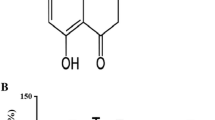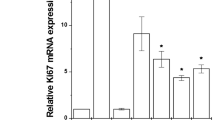Abstract
The citrus unshiu peel has been used traditionally as a medicine to improve bronchial and asthmatic conditions or cardiac and blood circulation in Korea, China, and Japan. Here, we report the effects of citrus unshiu peel water extract (CPWE) on the phorbol myristate acetate (PMA) + calcium ionophore A23187-induced hypoxia-inducible factor-1α (HIF-1α) activation and inflammatory cytokine production from the human mast cell line, HMC-1 cells. We compared CPWE with hesperidin, a common constituent of citrus unshiu. CPWE and hesperidin inhibited the PMA + A23187-induced HIF-1α expression and the subsequent production of vascular endothelial growth factor (VEGF). In addition, CPWE suppressed PMA + A23187-induced phosphorylation of the extracellular signal-regulated kinase (ERK). We also show that the increased cytokines interleukin (IL)-1β, IL-8, and tumor necrosis factor (TNF)-α level was significantly inhibited by treatment of CPWE or hesperidin. In the present study, we report that CPWE and hesperidin are inhibitors of HIF-1α and cytokines on the mast cell-mediated inflammatory responses.







Similar content being viewed by others
References
Park SH, Park EK, Kim DH (2005) Passive cutaneous anaphylaxis-inhibitory activity of flavanones from Citrus unshiu and Poncirus trifoliata. Planta Med 71:24–27
Suzuki M, Sasaki K, Yoshizaki F, Oguchi K, Fujisawa M, Cyong JC (2005) Anti-hepatitis C virus effect of citrus unshiu peel and its active ingredient nobiletin. Am J Chin Med 33:87–94
Jeong SM, Kim SY, Kim DR, Jo SC, Nam KC, Ahn DU, Lee SC (2004) Effect of heat treatment on the antioxidant activity of extracts from citrus peels. J Agric Food Chem 52:3389–3393
Murakami A, Nakamura Y, Torikai K, Tanaka T, Koshiba T, Koshimizu K, Kuwahara S, Takahashi Y, Ogawa K, Yano M, Tokuda H, Nishino H, Mimaki Y, Sashida Y, Kitanaka S, Ohigashi H (2000) Inhibitory effect of citrus nobiletin on phorbol ester-induced skin inflammation, oxidative stress, and tumor promotion in mice. Cancer Res 60:5059–5066
Kim DK, Lee KT, Eun JS, Zee OP, Lim JP, Eum SS, Kim SH, Shin TY (1999) Anti-allergic components from the peels of Citrus unshiu. Arch Pharm Res 22:642–645
Higashi-Okai K, Kamimoto K, Yoshioka A, Okai Y (2002) Potent suppressive activity of fresh and dried peels from Satsuma mandarin Citrus unshiu (Marcorv.) on hydroperoxide generation from oxidized linoleic acid. Phytother Res 16:781–784
Ansorge S, Reinhold D, Lendeckel U (2003) Propolis and some of its constituents own-regulate DNA synthesis and inflammatory cytokine production but induce TGF-beta1 production of human immune cells. Z Naturforsch [C] 58:580–589
Galati EM, Monforte MT, Kirjavainen S, Forestieri AM, Trovato A, Tripodo MM (1994) Biological effects of hesperidin, a citrus flavonoid (Note I): antiinflammatory and analgesic activity. Farmaco 40:709–712
Kim DH, Song MJ, Bae EA, Han MJ (2000) Inhibitory effect of herbal medicines on rotavirus infectivity. Biol Pharm Bull 23:356–358
Kaur G, Tirkey N, Chopra K (2006) Beneficial effect of hesperidin on lipopolysaccharide-induced hepatotoxicity. Toxicology 226(2–3):152–160
Wang GL, Semenza GL (1993) Characterization of hypoxia-inducible factor 1 and regulation of DNA binding activity by hypoxia. J Biol Chem 268:21513–21518
Wang GL, Semenza GL (1995) Purification and characterization of hypoxia-inducible factor 1. J Biol Chem 270:1230–1237
Yamashita K, Discher DJ, Hu J, Bishopric NH, Webster KA (2001) Molecular regulation of the endothelin-1 gene by hypoxia. Contributions of hypoxia-inducible factor-1, activator protein-1, GATA-2, AND p300/CBP. J Biol Chem 276:12645–12653
Shi YH, Wang YX, Bingle L, Gong LH, Heng WJ, Li Y, Fang WG (2005) In vitro study of HIF-1 activation and VEGF release by bFGF in the T47D breast cancer cell line under normoxic conditions: involvement of PI-3K/Akt and MEK1/ERK pathways. J Pathol 205:530–536
Qian D, Lin HY, Wang HM, Zhang X, Liu DL, Li QL, Zhu C (2004) Normoxic induction of the hypoxic-inducible factor-1 alpha by interleukin-1 beta involves the extracellular signal-regulated kinase 1/2 pathway in normal human cytotrophoblast cells. Biol Reprod 70:1822–1827
Mottet D, Michel G, Renard P, Ninane N, Raes M, Michiels C (2002) ERK and calcium in activation of HIF-1. Ann NY Acad Sci 973:448–453
Queralt M, Brazis P, Merlos M, de Mora F, Puigdemont A (2000) In vitro inhibitory effect of rupatadine on histamine and TNF-alpha release from dispersed canine skin mast cells and the human mast cell line HMC-1. Inflamm Res 49:355–360
Kruger-Krasagakes S, Grutzkau A, Krasagakis K, Hoffmann S, Henz BM (1999) Adhesion of human mast cells to extracellular matrix provides a co-stimulatory signal for cytokine production. Immunology 98:253–257
Hosoda M, Yamaya M, Suzuki T, Yamada N, Kamanaka M, Sekizawa K, Butterfield JH, Watanabe T, Nishimura H, Sasaki H (2002) Effects of rhinovirus infection on histamine and cytokine production by cell lines from human mast cells and basophils. J Immunol 169:1482–1491
Kim MS, Na HJ, Han SW, Jin JS, Song UY, Lee EJ, Song BK, Hong SH, Kim HM (2003) Forsythia fructus inhibits the mast cell-mediated allergic inflammatory reactions. Inflammation 27:129–135
Ben Trivedi A, Kitabatake N, Doi E (1990) Toxicity of dimethyl sulfoxide as a solvent in bioassay system with HeLa cells evaluated colorimetrically with 3-(4,5-dimethylthiazol-2-yl)-2,5-diphenyl-tetrazolium bromide. Agric Biol Chem 54:2961–2966
Kim SJ, Jeong HJ, Choi IY, Lee KM, Park RK, Hong SH, Kim HM (2005) Cyclooxygenase-2 inhibitor SC-236 [4-[5-(4-chlorophenyl)-3-(trifluoromethyl)-1-pyrazol-1-l] benzenesulfonamide] suppresses nuclear factor-kappaB activation, phosphorylation of p38 mitogen-activated protein kinase, extracellular signal-regulated kinase, and c-Jun N-terminal kinase in human mast cell line cells. J Pharmacol Exp Ther 314:27–34
Haddad JJ, Harb HL (2005) Cytokines and the regulation of hypoxia-inducible factor (HIF)-1alpha. Int Immunopharmacol 5:461–483
Manjula N, Gayathri B, Vinaykumar KS, Shankernarayanan NP, Vishwakarma RA, Balakrishnan A (2006) Inhibition of MAP kinases by crude extract and pure compound isolated from Commiphora mukul leads to down regulation of TNF-alpha, IL-1beta and IL-2. Int Immunopharmacol 6:122–132
Acuna-Castillo C, Aravena M, Leiva-Salcedo E, Perez V, Gomez C, Sabaj V, Nishimura S, Perez C, Colombo A, Walter R, Sierra F (2005) T-kininogen, a cystatin-like molecule, inhibits ERK-dependent lymphocyte proliferation. Mech Ageing Dev 126:1284–1291
Lin N, Sato T, Takayama Y, Mimaki Y, Sashida Y, Yano M, Ito A (2003) Novel anti-inflammatory actions of nobiletin, a citrus polymethoxy flavonoid, on human synovial fibroblasts and mouse macrophages. Biochem Pharmacol 65:2065–2071
Kim MJ, Park HJ, Hong MS, Park HJ, Kim MS, Leem KH, Kim JB, Kim YJ, Kim HK (2005) Citrus Reticulata blanco induces apoptosis in human gastric cancer cells SNU-668. Nutr Cancer 51:78–82
Poulose SM, Harris ED, Patil BS (2005) Citrus limonoids induce apoptosis in human neuroblastoma cells and have radical scavenging activity. J Nutr 135:870–877
Li S, Pan MH, Lai CS, Lo CY, Dushenkov S, Ho CT (2007) Isolation and syntheses of polymethoxyflavones and hydroxylated polymethoxyflavones as inhibitors of HL-60 cell lines. Bioorg Med Chem 15:3381–3389
Kawaguchi K, Maruyama H, Kometani T, Kumazawa Y (2006) Related Articles, Links Suppression of collagen-induced arthritis by oral administration of the citrus flavonoid hesperidin. Planta Med 72:477–479
Galati EM, Monforte MT, Kirjavainen S, Forestieri AM, Trovato A, Tripodo MM (1994) Biological effects of hesperidin, a citrus flavonoid. (Note I): antiinflammatory and analgesic activity. Farmaco 40:709–712
Sandau KB, Zhou J, Kietzmann T, Brune B (2001) Regulation of the hypoxia-inducible factor 1alpha by the inflammatory mediators nitric oxide and tumor necrosis factor-alpha in contrast to desferroxamine and phenylarsine oxide. J Biol Chem 276:39805–39811
Thornton RD, Lane P, Borghaei RC, Pease EA, Caro J, Mochan E (2000) Interleukin 1 induces hypoxia-inducible factor 1 in human gingival and synovial fibroblasts. Biochem J 350:307–312
Jung YJ, Isaacs JS, Lee S, Trepel J, Neckers L (2003) IL-1beta-mediated up-regulation of HIF-1alpha via an NFkappaB/COX-2 pathway identifies HIF-1 as a critical link between inflammation and oncogenesis. FASEB J 7:2115–2117
Albina JE, Mastrofrancesco B, Vessella JA, Louis CA, Henry WL Jr, Reichner JS (2001) HIF-1 expression in healing wounds: HIF-1alpha induction in primary inflammatory cells by TNF-alpha. Am J Physiol Cell Physiol 281:C1971–C1977
Semenza GL, Agani F, Booth G, Forsythe J, Iyer N, Jiang BH, Leung S, Roe R, Wiener C, Yu A (1997) Structural and functional analysis of hypoxia-inducible factor 1. Kidney Int 51:553–555
Varayoud J, Ramos JG, Bosquiazzo VL, Munoz-de-Toro M, Luque EH (2004) Mast cells degranulation affects angiogenesis in the rat uterine cervix during pregnancy. Reproduction 127:379–387
Hur E, Chang KY, Lee E, Lee SK, Park H (2001) Mitogen-activated protein kinase kinase inhibitor PD98059 blocks the trans-activation but not the stabilization or DNA binding ability of hypoxia-inducible factor-1alpha. Mol Pharmacol 59:1216–1224
Sodhi A, Montaner S, Patel V, Zohar M, Bais C, Mesri EA, Gutkind JS (2000) The Kaposi’s sarcoma-associated herpes virus G protein-coupled receptor up-regulates vascular endothelial growth factor expression and secretion through mitogen-activated protein kinase and p38 pathways acting on hypoxia-inducible factor 1alpha. Cancer Res 60:4873–4880
Qian D, Lin HY, Wang HM, Zhang X, Liu DL, Li QL, Zhu C (2004) Involvement of ERK1/2 pathway in TGF-beta1-induced VEGF secretion in normal human cytotrophoblast cells. Mol Reprod Dev 68:198–204
Frede S, Stockmann C, Freitag P, Fandrey J (2006) Bacterial lipopolysaccharide induces HIF-1 activation in human monocytes via p44/42 MAPK and NF-kappaB. Biochem J 396:517–527
Anderson DF, MacLeod JD, Baddeley SM, Bacon AS, McGill JI, Holgate ST, Roche WR (1997) Seasonal allergic conjunctivitis is accompanied by increased mast cell numbers in the absence of leucocyte infiltration. Clin Exp Allergy 27:1060–1066
Nishimoto N (2005) Cytokine signal regulation and autoimmune disorders. Autoimmunity 38:359–367
Taylor PC (2001) Anti-TNF therapy for rheumatoid arthritis and other inflammatory diseases. Mol Biotechnol 19:153–168
Lu Y, Zhang C, Bucheli P, Wei D (2006) Citrus flavonoids in fruit and traditional Chinese medicinal food ingredients in China. Plant Foods Hum Nutr 61:57–65
Acknowledgment
This work was supported by the Korea Research Foundation Grant funded by the Korean Government (MOEHRD) (R05-2003-000-11803-0).
Author information
Authors and Affiliations
Corresponding author
Rights and permissions
About this article
Cite this article
Choi, IY., Kim, SJ., Jeong, HJ. et al. Hesperidin inhibits expression of hypoxia inducible factor-1 alpha and inflammatory cytokine production from mast cells. Mol Cell Biochem 305, 153–161 (2007). https://doi.org/10.1007/s11010-007-9539-x
Received:
Accepted:
Published:
Issue Date:
DOI: https://doi.org/10.1007/s11010-007-9539-x




